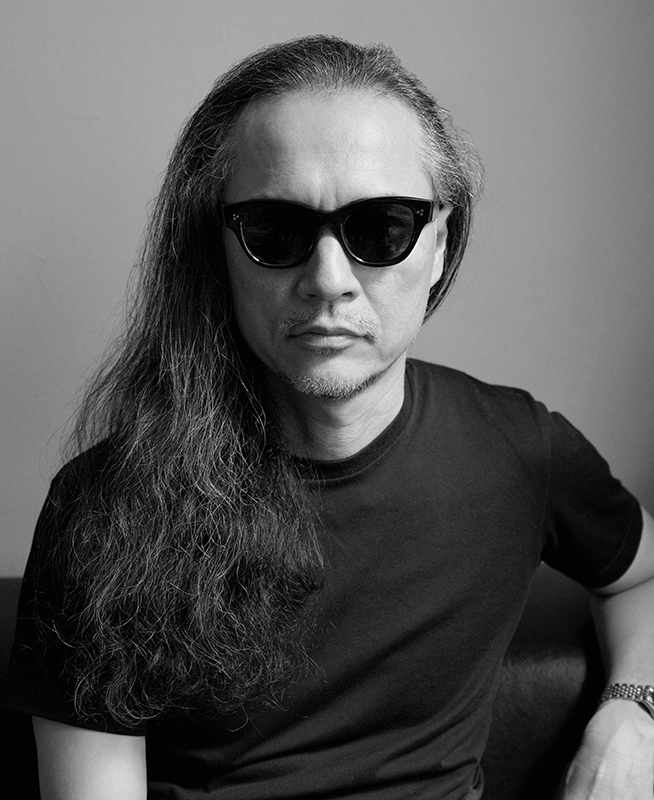Abe relocated to New York City from Tokyo in the early 1990s. His graduate school studies, which initially focused on photography, correlated with a significant transitional period of technology in art. Digital processes and media were emerging as new options for photography and other art forms. Digital technology became a fundamental aspect of Abe’s artwork and it continues to function as both a method and as a conceptual basis for his art.
Abe has often explored the issues of culture, technology, and the history of art through his artwork. A sequence of individual art projects, each arranged and titled as a specific “Chapter,” form his Digital Art framework. Each Chapter is a discrete examination of one or more core conceptual issues and the related dynamics of culture, technology, and the status of art. Abe had already been exploring and creating digitally constructed art for some time when he completed the first project of the series, Digital Art Chapter One (2000), which examines culture, technology and art conceptually through digitally constructed works. Digitally-based images were, as yet, rarely seen in art galleries and museums. Digitally constructed artwork like Abe’s Digital Art Chapter One reflected an innovation in art making, conceptually and materially, of the period. Abe later refined and expanded his baseline concept of the Digital Art series into a larger conceptual framework, Topology of Art.
Following Digital Art Chapter One, Abe created Seamless (Digital Art Chapter 2) and Digital Art Chapter 1.5. Both projects reflect his philosophical basis in photography. The projects, early digital constructions, consist of photographed “sets,” theme parks, and recreated historical locations with digitally inserted figures. In Seamless and Chapter 1.5, Abe examines the relationship between the concepts of current or past, and between real or fake by mixing “real” or “fake” photographs of people and places. Abe’s fundamental inquiry in these projects has become increasingly relevant with the further inclusion of technology in life and art.
Through his artwork Abe has considered the essential value of art within a culture and the role of art and human status within a material culture. For example, in Display (Digital Art Chapter 3), Abe placed figures from historic portrait paintings into “real” photographic locations—Ikea showroom displays. In Display Abe conceptually examines the relationship of socioeconomic status and art. Exclusivity (exemplified by the prototypical privileged status of the human subjects) and contemporary mass culture intertwine within the dynamic of the history of art and in the context of digital art media.
Abe’s Japanese culture and art history have been sources of artistic conceptual material in many of his works. For example, in his Hara-Kiri project (Digital Art Chapter 4) Abe applied a conceptual act of hara-kiri (ritual suicide) upon masterworks of Western art. Taking a metaphorical katana to the basis of Western art, Abe digitally removed the essential subject matter of the paintings and exposed the substance and significance of that which was digitally excised.
Through his art Abe has confronted the interaction between Japanese art and Western art and the implicit value that is placed upon each in the western-centric canon of art history. In Analogies (Digital Art Chapter 5), Abe digitally applied traditional Japanese tattoos to the human figures of Western masterpiece paintings. Abe states that his act of “tattooing” these works is a proposition that exposes parallel complexities among societies, cultures, and art, but also the social hierarchies within cultural art forms. Works from the Analogies series are held in the collections of the British Museum and the Musée Ingres Bourdelle.
On March 11, 2011 the Tohoku region of Northern Japan was devastated by an earthquake and tsunami that resulted in the deaths of approximately 20,000 people and the utter destruction of numerous cities and towns. The event had a strong personal effect upon Abe, who was born in the area and spend his youth there. The loss of life was unimaginable and places he knew intimately were literally washed away with the tsunami wave. In response, Abe created the Animism project (Digital Art Chapter 6) which deals deeply with the culture, beliefs, and religious nature of Japanese society in the face of an overwhelming act of nature. Abe has said that the Animism project further served to complete his earlier project, Hara-Kiri. Both projects are based upon his concept that 'the essence of existence is only apparent when existence has ceased to be.' Taken together, Hara-Kiri and Animism resolve Abe’s original supposition. The full Animism series, consisting of 26 prints, was acquired by the British Museum.
Abe continues to work within his Topology of Art framework. Topology (Topology of Art Chapter 7) proposes a non-Euclidian version of art history as a companion to the existing academic standards. Aesthetic(s) (Topology of Art Chapter 8) considers an intercultural aesthetic comparison within the Japanese concept of déforme. Duplication/American Original (Topology of Art Chapter 9) examines art and contemporary society as a dialogue between a traditional Japanese art form and American graphic art. It is, in part, an homage to Roy Lichtenstein, but in Duplication, Abe further intermixes the Japanese and American images as a commentary on that distinct cultural interaction. In Vantage Point (Topology of Art Chapter 10) Abe conceptually and materially reexamines the inherent perspective of art and the way that it changes depending upon the viewer’s cultural or social position. Abe exchanged certain elements of European masterworks to create new and diverging narratives within the art itself. But, Abe has also proposed that the process is a digital method of eliminating himself, the artist, from the artwork that he creates.
Koya Abe's artwork has been extensively exhibited domestically in the United States and internationally. His most recent project is entitled Kabuki.

Studies in photography with the International Center of Photography
Contact us for exhibition & reproduction requests, press information, and for any other inquiries.